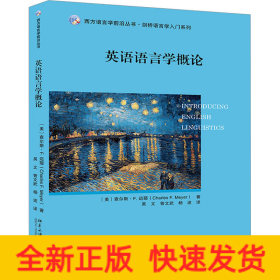
英语语言学概论 李郁等 著 东北师范大学出版社 9787560250892
¥ 9.75 3.3折 ¥ 30 八五品
仅1件
作者李郁等 著
出版社东北师范大学出版社
ISBN9787560250892
出版时间2007-12
版次1
装帧平装
开本16开
纸张胶版纸
页数281页
定价30元
货号9787560250892
上书时间2024-03-26
- 在售商品 暂无
- 平均发货时间 8小时
- 好评率 暂无
- 最新上架
商品详情
- 品相描述:八五品
- 商品描述
-
基本信息
书名:英语语言学概论
定价:30.00元
作者:李郁等 著
出版社:东北师范大学出版社
出版日期:2007-12-01
ISBN:9787560250892
字数:
页码:281
版次:
装帧:平装
开本:16开
商品重量:
编辑推荐
内容提要
《英语语言学概论》汲取了语言学重要的研究成果,以国内高等学校的英语专业本科生为教授对象,内容针对性强,按照简化学习程序,特别是将知识点提炼出来,结合其他同类教材进行综合、整理的原则,利用联想的方式加深理解记忆,帮助学生更容易、系统地了解语言学知识。书后提供了语言学主要术语英汉和汉英对照表及参考书目,以方便读者在阅读教材或其他语言学著作碰到生词时翻阅查找。因此,《英语语言学概论》具有很强的可操作性。
目录
Part 0neCHAPTER ONE Introduction1.1 What is language?1.2 Desigfeatures of language1.2.1 Arbitrariness1.2.2 Duality1.2.3 Creativity1.2.4 Displacement1.2.5 Cultural Transmission1.3 Functions of language1.4 What is linguistics?1.5 Scope of linguistics1.6 Some important distinctions ilinguistics1.6.1 Descriptive&Prescriptive1.6.2 Synchronic&Diachronic1.6.3 Langue&Parole1.6.4 Competence&PerformanceStudy questionsCHAPTER TWO Speech Sounds2.1 Phonetics2.1.1 Classificatioof English consonants2.1.2 Classificatioof English Vowels2.2 Orthographic representatioof speech sounds——brOad and narrow transcriptionsStudy questionsCHAPTER THREE Phonology3.1 Phonemes3.2 Phones and Allophones3.3 Phonemic contrast,Complementary distribution,and Minimal pair3.4 Syllables and clusters3.5 Prosodic phonology and Suprasegmental phonology3.6 Co_articulatioeffects3.6.1 ASSimilation3.6.2 Ehslon3.6.3 DissimilationStudy questionsCHAPTER FOUR Morphology-Structure of Words4.1 Opeclass and closed class4.2 Morphology4.2.1 Morphemes4.2.2 Morphs and allomorphs4.2.3 Morpheme and phoneme4.3 Morphemic structure and phonological structure4.4 Word formation4.4.1 Derivation4.4.2 Compounding4.4.3 Inflection4.4.4 Borrowing words4.4.5 Blending4.4.6 Abbreviation4.4.7 Acronym4.4.8 Back formationStudy questionsCHAPTER FIVE Syntax-Sentence Patterns5.1 The traditional approach5.1.1 Concord and government5.2 The structural approach5.2.1 Syntagmatic and paradigmatic relations5.2.2 Symbols used isyntactic description5.2.3 Labeled tree diagrams5.2.4 Phrase structure rules5.2.5 Recursion5.3 The generative approach5.3.1 Noam Chomsky5.3.2 Transformational rules5.4 The functional approach5.4.1 Functional sentence perspective5.4.2 Systemic—Functional grammarStudy questionsCHAPTER SIX Discourse Analysis6.1 Historical development of discourse analysis6.2 Definitioof discourse analysis6.3 Basic framework for the study of discourse6.3.1 Language as System and as Activity6.3.2 Language use with Purpose and Function6.3.3 Language iSituation6.3.4 Community Context6.4 Cohesion6.4.1 Reference6.4.3 Ellipsis6.4.4 Coniunction6.4.5 Lexical cohesion6.4.6 Lexical net6.5 CoherenceStudy questionsCHAPTER SEVEN Semantics7.1 The meaning of“meaning”7.2 Some views concerning the study of meaning7.2.1 The naming theory7.2.2 The conceptuatist view7.2.3 Behaviorism7.3 Word meaning7.4 Conceptual vs.associative meaning7.5 Sense relations7.5.1 Synonymy7.5.2 Antonymy7.5.3 Polysemy7.5.4 Hyponymy7.5.5 Prototypes7.6 Sense relations betweesentences7.6.1 Entailment7.6.2 Presupposition7.6.3 Synonymy7.6.4 Contradiction7.6.5 Tautology7.6.6 Inconsistency7.6.7 Anomaly7.7 Analysis of meaning——semantic features7.7.1 Componential analysis7.7.2 Predicational analysisStudy questionsCHAPTER EIGHT Pragmatics8.1 Sentence meaning vs.discourse meaning8.2 Presupposition8.3 Speech events8.4 Speech act theory8.5 The theory of conversational implicature8.5.1 Cooperative Principle(CP)8.5.2 Politeness Principle(PP)8.6 ConversatiOnal interactionStudy questionsCHAPTER NINE language.Culture and Society9.1 Language and culture9.1.1 Sapir-Whorf hypothesis9.2 Language and society9.2.1 Speech community and speech variety9.2.2 Varieties of language9.2.3 Register9.2.4 Standard dialect9.2.5 Pidgiand Creole9.2.6 Bilingualism and diglossiaStudy questionsCHAPTER TEN First Language Acquisition10.1 Theories of child language acquisition10.1.1 A behaviorist view of language acquisition10.1.2 Ainnatist view of language acquisition10.1.3 Ainteractionist view of language acquisition10.2 Language environment and the Critical Period Hypothesis10.3 Stages ichild language development10.3.1 Phonological development10.3.2 The one—word or holophrastic stage10.3.3 TWO—word stage10.3.4 Telegraphic stage10.3.5 Atypical DevelopmentStudy questionsCHAPTER ELEVEN Second Language Acquisition11.1 Acquisitioand learning11.2 The nature of second language learning11.3 Major L2 learning theories11.3.1 The interlanguage theory11.3.2 Input and output theories11.3.3 Contrastive analysis11.3.4 The affective filter hypothesis11.4 Second language acquisitioand its pedagogical implicationsStudy questionsCHAPTER TWELVE ModerLinguistics Schools and Theories12.1 Ferdinand de Saussure12.2 The Prague School12.3 Functional Sentence Perspective(FSP)12.4 Americastructuralism12.5 Transformational-Generative Grammar12.6 Chomsky’S innateness hypothesis12.7 The LondoSchool12.8 Halliday’S functional grammarlaart TWO章 概述本章概述要点分析名词解释参考答案第二章 语音本章概述要点分析名词解释参考答案第三章 音系学本章概述要点分析名词解释参考答案第四章 形态学——单词的结构本章概述要点分析名词解释参考答案第五章 句法学——句子的模式本章概述要点分析名词解释参考答案第六章 话语分析本章概述要点分析名词解释参考答案第七章 语义学本章概述要点分析名词解释参考答案第八章 语用学本章概述要点分析名词解释参考答案第九章 语言、文化与社会本章概述要点分析名词解释参考答案第十章 语言习得本章概述要点分析名词解释参考答案第十一章 第二语言习得本章概述要点分析名词解释参考答案第十二章 现代语言学流派与理论本章概述要点分析GIossary语言学主要术语英汉对照表语言学主要术语汉英对照表References
作者介绍
序言
-

【封面】
相关推荐
— 没有更多了 —




















以下为对购买帮助不大的评价